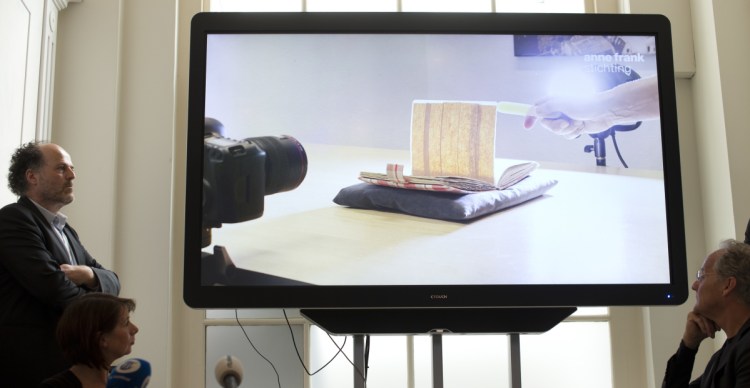AMSTERDAM – Researchers using digital technology deciphered the writing on two pages of Anne Frank’s diary that she had pasted over with brown masking paper, discovering four naughty jokes and a candid explanation of sex, contraception and prostitution.
“Anyone who reads the passages that have now been discovered will be unable to suppress a smile,” said Frank van Vree, director of the Netherlands Institute for War, Holocaust and Genocide Studies. “The ‘dirty’ jokes are classics among growing children. They make it clear that Anne, with all her gifts, was above all also an ordinary girl.”
Anne, age 13 at the time, wrote the two pages on Sept. 28, 1942, less than three months after she, her family and another Jewish family went into hiding from the Nazis in a secret annex behind a canal-side house in Amsterdam.
Later on, possibly fearing prying eyes or no longer liking what she had written, she covered them over with brown paper with an adhesive backing like a postage stamp, and their content remained a tantalizing mystery for decades.
It turns out the pages contained four jokes about sex that Anne herself described as “dirty” and an explanation of women’s sexual development, sex, contraception and prostitution.
“They bring us even closer to the girl and the writer Anne Frank,” Ronald Leopold, executive director of the Anne Frank House museum, said Tuesday.
Experts on Anne’s multimillion-selling diary said the newly discovered text, when studied with the rest of her journal, reveals more about her development as a writer than it does about her interest in sex.

Teresien da Silva, left, and Ronald Leopold of the Anne Frank Foundation were among those announcing “new information about the diary” at the Anne Frank House in Amsterdam, Netherlands, on Tuesday.
Anne wrote candidly in other parts of her diary about her burgeoning sexuality, her anatomy and her impending period. Those passages were censored by her father before the diary was first published in 1947 but became available in more recent unabridged editions.
Leopold said the newly deciphered material provides an early example of how Anne “creates a fictional situation that makes it easier for her to address the sensitive topics that she writes about.” In her diary, for example, she addressed entries to a fictional friend named Kitty.
The institutions involved in the latest research said that because of copyright issues, it is unclear whether the passages will be incorporated into new editions.
The deciphering was done by researchers from the Anne Frank museum, the Institute for War, Holocaust and Genocide Studies and the Huygens Institute of Netherlands History.
They photographed the pages, backlit by a flash, and then used image-processing software to decipher the words, which were hard to read because they were jumbled up with the writing on the reverse sides of the pages.
In the passage on sex, Anne described how a young woman gets her period around age 14, saying that it is “a sign that she is ripe to have relations with a man but one doesn’t do that of course before one is married.”
On prostitution, she wrote: “All men, if they are normal, go with women, women like that accost them on the street and then they go together. In Paris they have big houses for that. Papa has been there.”
One of her jokes was this: “Do you know why the German Wehrmacht girls are in Holland? As mattresses for the soldiers.”
She also related this joke: “A man had a very ugly wife and he didn’t want to have relations with her. One evening he came home and then he saw his friend in bed with his wife, then the man said: ‘He gets to and I have to!!!”‘
Anne wrote her diary while she and her family hid for more than two years during World War II. The family went into hiding in July 1942 and remained there, provided with food and other essentials by a close-knit group of helpers, until Aug. 4, 1944, when they were discovered and ultimately deported to Auschwitz.
Only Anne’s father, Otto Frank, survived the war. Anne and her sister died in Bergen-Belsen camp. Anne was 15.
After the war, Otto Frank had his daughter’s diary published, and it went on to become a symbol of hope and resilience that has been translated into dozens of languages.
The house where the Franks hid was turned into a museum that is one of Amsterdam’s most popular tourist attractions.
Send questions/comments to the editors.



Comments are no longer available on this story